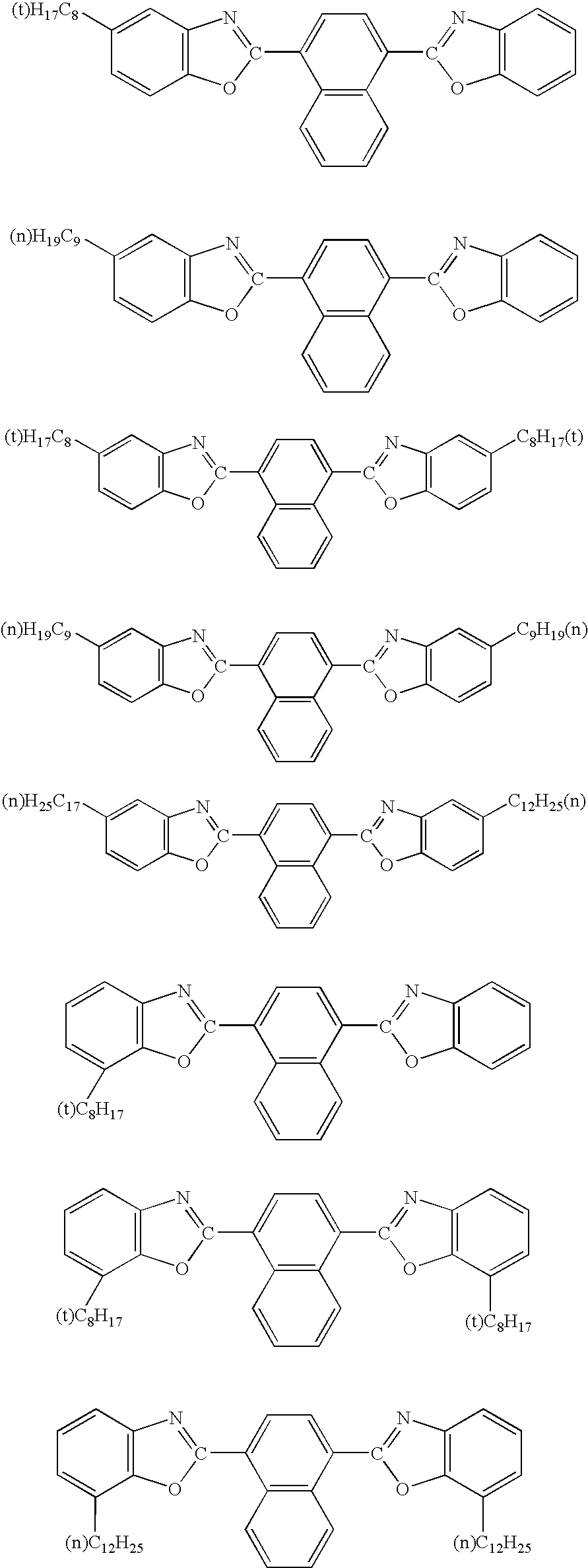[0008]In accordance with the present invention, there is provided novel light reflecting and fluorescent molded or extruded articles comprising a
thermoplastic or thermosetting
polymeric matrix having dispersed particles of an optical brightening agent therein, these articles having a
reflectivity high enough to enhance the efficiency of fluorescent illumination sources. The molded article can be in the form of a
solid piece formed from opaque, translucent, or partially translucent
polymer material. Alternatively, the instant light reflective, fluorescent polymeric composition can be extruded into fluorescent sheets, fibers or filaments (fine fibers), the fluorescent fibers being one preferred embodiment of the polymeric articles of the present invention. The fluorescent fibers of the instant invention are preferably at least partially translucent and made in an
extrusion process, and the fibers comprise a durable polymeric material which is at least partially translucent and an optical brighteneing agent comprised of a benzoxazolyl
naphthalene. The fluorescent fiber of the present invention has a cross sectional dimension of less than approximately 0.02 in. and preferably in the range of between 0.002 in. and 0.004 in. and the fiber is preferably made of a material selected from
polyolefin,
polyamide, polyesters, polyacrylonitriles and
polyvinyl chloride polymers.
[0009]The purpose of the benzoxazolyl napthalene optical brightener in the
polymer composition of the instant invention is to make any clear areas of a fiber or molded structure appear even brighter and to fluoresce upon
exposure to a UV source. The optical brightener fluoresces upon
irradiation with UV (
ultraviolet) light, emitting visible light, usually bluish in
hue, thereby enhancing the brightness of the fiber substrate. Optical brighteners for use in the instant polymer materials must absorb UV light, especially in the region from 300 to 420 nm (nanometers), and emit this energy as visible light in the
wavelength range of from about 400 to 470 nm to enhance the brightness of the polymeric article or fiber. The enhanced light reflectivity of the instant compositions occurs over a
wavelength range of from about 400 to 700 nanometers which renders a fluorescent source efficient. The optical brightener must also be stable to temperatures as high as from 310 C to 330 C, which are used in
processing the optical brightener into the polymeric material (eg.
polyolefin) and in extruding the polymer into fiber.
[0012]More precisely, in a preferred embodiment the invention is directed to a fiber substrate support element comprised of a clear polymeric base material and at an optical brightener comprising 1,4-di(benzoxazolyl-2′)
naphthalene and bis(
alkyl substituted benzoxazolyl) naphthalene derivatives. The polymeric material used in the fiber embodiment of the instant invention is preferably clear to the extent of being at least partially translucent. The compounds of the invention comprise the class of naphthalene derivatives having benzoxazolyl subsituents in the 1,4 positions of the naphthalene radicals. The compounds of this class have unexpectedly superior fluorescent properties when used as whitening or brightening agents and, in addition, have certain other properties such as
heat stability (for melt
processing), light stability, stability toward bleaches and other oxidizing environments, stability in fiber
processing treatments, etc., which make them especially useful as whitening or brightening agents for
textile materials, particularly synthetic linear extruded fiber such as
polyvinyl chloride.
[0013]The methods employed for preparation of the instant invention are generally well known and comprise the steps of mixing the benzoxazolyl naphthalene brightener particles with an unhardened polymeric material, heating the mixture to form a
polymer melt, and alternatively (i) extruding the
resultant mixture to form fibers having sectional dimensions which preferably are less than approximately 0.020 in. but greater than 0.002 in. or (ii) molding the melt to form a three dimensional reflective article. In accordance with these methods, the brightener particles are preferably first premixed with a
coating agent, which is suitable for
coating the brightener particles. In this regard, it has been found that the use of these agents of this type effectively enhances the distribution of the benzoxzolyl naphthalene brightener particles in finished fibers or molded articles so that these polymeric articles have substantially uniformly fluorescent properties and so that they are not significantly weakened by areas of high concentrations of the brightener particles therein.
[0014]The simplicity of the instant composition and the various applications employing its use provide a readily
usable process employing available equipment and preliminary mixing cycle instructions. The instant process and outlined procedures allows a manufacturer to use existing mixing equipment such as injection molding,
extrusion,
blow molding, roto-cast and
compression molding tools. Flexibility is an option in that the manufacturing process may be change based on the ready availability of production equipment. In addition, the instant naphthalene optical brightener or whitener can be use in many popular plastics such as polyvinylchloride (PVC),
polyethylene (PE),
polypropylene (PP),
polystyrene (PS),
ethylene vinyl acetate (EVA),
cellulose acetate (CA),
polyethylene vinyl acetate (PEVA),
styrene butadiene
copolymer such as acetyl butadiane
styrene (ABS), polyesters,
acrylonitrile polymers and copolymers, and polyamides. In a preferred specific embodiment, 1,4-Bis(benzoxazolyl-2-yl) naphthalene is a fluorescent whitening agent that can be readily used within the purview of the instant invention for whitening and brightening plastic injection molded fiber materials employed in doll hair.
 Login to View More
Login to View More 

